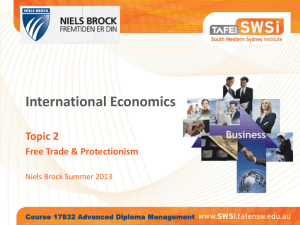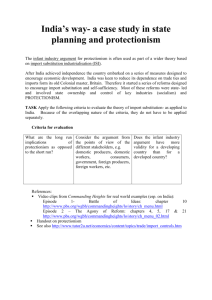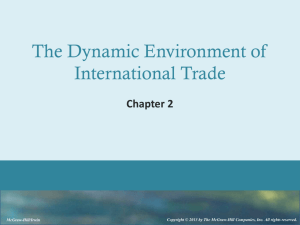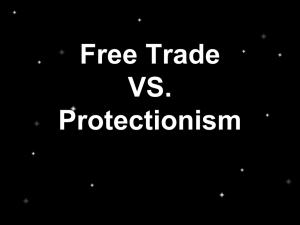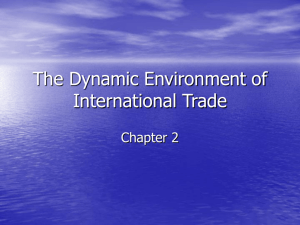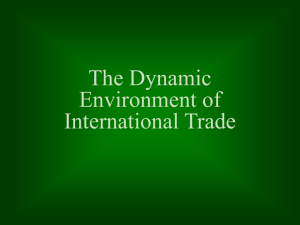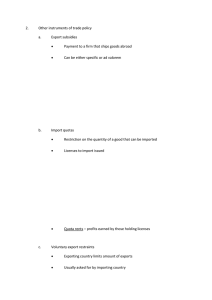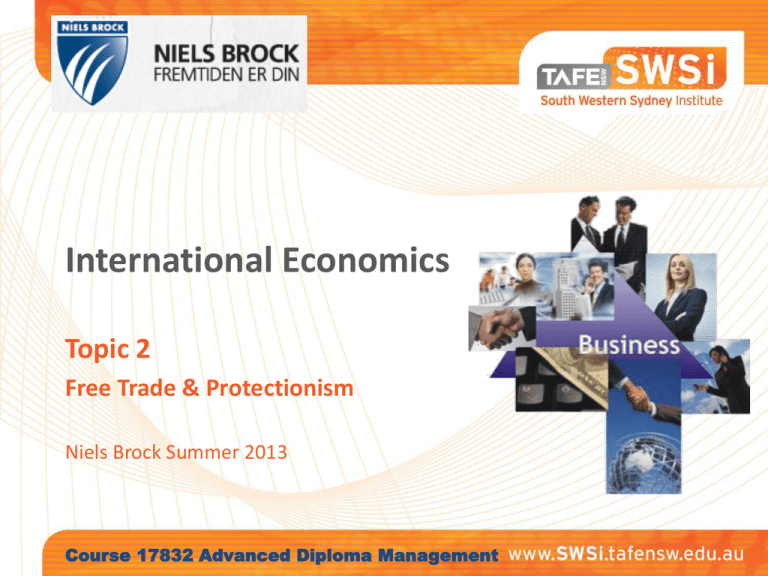
International Economics
Topic 2
Free Trade & Protectionism
Niels Brock Summer 2013
Course 17832 Advanced Diploma Management
Names
• Write names on folded piece of paper
REVISION
Topic 1 Why Do Countries Trade?
• Questions from readings?
Topic 2
Free Trade & Protectionism
1. International Organisations and Agreements
2. Free Trade
3. Arguments for Protectionism
4. Arguments against Protectionism
4
CHINA
Is CHINA a super power just because it has cheap
labour?
CHINA
China has 19% of the world’s population, but
consumes
• 53% of the world's cement
• 48% of the world's iron ore
• 47% of the world's coal
• And the majority of just about every other major
commodity.
• In 2010, China produced
11 times more steel than the
United States
CHINA
• New World Record: China made and sold 18
million vehicles in 2010.
CHINA
• There are more pigs in China than in the next
43 pork producing nations combined.
CHINA
• China has the world’s fastest train and the
world’s largest high-speed rail network
CHINA
• They manufacture 80% of the world’s solar
panels,
• They install less than 5% and build a new coal
fired power station every week.
• In 1 year they turn on more new coal powered
electricity than Australia 's total output.
CHINA
• China currently controls more than 90% of the
total global supply of rare earth elements.
CHINA
• In the past 15 years, China has moved from
14th place to 2nd place
• in the world in published scientific
research articles.
CHINA
• China possesses the fastest supercomputer on
the entire globe.
CHINA
• Chinese consume 50,000 cigarettes every
second
CHINA
• At the end of March 2011, China accumulated
US$3.04 trillion in foreign currency reserves the largest stockpile on the entire globe.
U.S. Debt
In 2011, spending in Washington, and the months-long political wrangling
has almost certainly done damage to their struggling economy.
The deal passed by Congress and signed Tuesday by President Barack
Obama increases the debt limit by more than $2 trillion.
It also calls for cuts in government spending of at least $2.1 trillion. But
those cuts are spread out over the next 10 years. Only $25 billion will be
cut next year.
The legislation also sets up a 12-member congressional panel tasked with
finding an additional $1.5 trillion in savings over the next 10 years. The
panel is supposed to present a report by Thanksgiving.
So how much is $1 Trillion?.....
$100 bill
17
$USD 10,000
18
$1 Million (100 packets of $10K)
19
$100 Million
20
$1 BILLION
21
$1 TRILLION?
a million million.
It's a thousand billion.
$1 000 000 000 000
Ladies and gentlemen. I give you $1 trillion dollars.
22
$1 TRILLION
And notice those pallets are double stacked.
US debt
16.6 trillion
Trade Organisations
and Agreements
International Economics
Cooperative trading
arrangements
• World Trade Organisation is the peak body for managing
world-wide trade
•
•
•
•
•
Membership based
Sets rules
Resolves disputes
Hosts negotiation “rounds” (most recent was Doha round)
Strategically reduces global tariffs
• Previously GATT (Global Agreement on Tariffs and Trade)
• Is required to cooperate with other worldwide insititutions IMF
and World Bank
Organisations - WTO
• Research the most recent Doha trade negotiations at
wto.org and discover:
• How have the negotiations progressed?
• What are the problems with coming to agreement?
Some research
• International Monetary Fund
• International organisation that focusses on stabilising global monetary and financial
systems with mandate to focus on trade, stabilising exchange and Balance of Payments
• Common members (approximately 150) with WTO and has observer status in WTO
• Inputs to WTO policy debates and decisions (via research)
• World Bank
•
Provides finance to developing countries to reduce poverty
• OECD
• Economic Forums
•
•
•
•
•
•
G20
G8
EU
APEC (Asia Pacific Economic Cooperation)
EFTA (Euro Free Trade Association)
Others
Other trade-related
organisations
• How does the WTO and IMF work together?
• What does the OECD do?
• Who are in the G20, G8, EFTA and APEC and what do
they do?
• What are some of the other forums designed to improve
trade and trade relations?
Research – GROUP ACTIVITY
• Bilateral
• Regional (often via trade cooperation forums)
• Multilateral (usually under the auspices of WTO)
Levels of trading
agreements
• http://www.wto.org/english/forums_e/debates_e/debate6_
e.htm
• Questions
1. Summarise in your own words the main points from
this forum
2. What are the stated achievements of multilateral trade
agreements via the WTO (and GATT) processes?
3. Does the panel believe that world trading system has
benefitted both developed and developing economies?
What arguments do they put forward.
Multilateral trade agreements and the WTO
• Who do the EU and Denmark have trade agreements
with?
• What type are they?
• Any currently in negotiation?
Research - Free Trade in
Denmark and the EU
TRADE
The Australian experience
Export market
Import market
1. China (23.7%)
2. Japan (16.4%)
3. Republic of Korea (8.2%)
4. India (6.1%)
5. United States (4.8%)
6. New Zealand (3.7%)
7. United Kingdom (3.6%)
8. Taiwan (3.2%)
9. Singapore (2.8%)
10. Thailand (2.7%)
APEC 75.3% ASEAN 11.1%
EU 8.8% OECD 43.8%
TOTAL EXPORT VALUE AUD$297.5b
1. China (15.5%)
2. United States (13.1%)
3. Japan (6.8%)
4. Singapore (5.5%)
5. Germany (4.2%)
6. Thailand (4.0%)
7. United Kingdom (3.8%)
8. New Zealand (3.6%)
9. Malaysia (3.6%)
10. Indonesia(2.8%)
APEC 70.9% ASEAN 14.4%
EU 13.5% OECD 46.3%
TOTAL IMPORT VALUE AUD$276.6b
Australia’s major trading partners 2010-11
Source DFAT 2012
1.
2.
3.
4.
5.
6.
7.
8.
9.
10.
China 19.7%%
Japan 11.8%
United States 8.8%
Republic of Korea 5.5%
Singapore 4.1%
United Kingdom 3.7%
New Zealand 3.7%
India 3.7%
Thailand 3.3%
Malaysia 2.7%
Australia top two-way
trading partners 2010-11
Source: DFAT 20012, ABS catalogue 5368.0 (2012)
1.
2.
3.
Iron ore & concentrates
Coal
Education-related travel
service
4. Gold (b)
5. Personal travel (excl
education) services
6. Crude petroleum
7. Natural gas
8. Wheat
9. Aluminium ores & conc
(incl alumina)
10. Copper ores &
concentrates
11.
12.
13.
14.
15.
16.
17.
18.
19.
20.
Aluminium
Beef,
Copper
Technical & other business
services
Medicaments (incl veterinary)
Business travel services
Professional services
Passenger transport services (d)
Refined petroleum
Wool & other animal hair (incl
tops)
Australia’s top exports 2010-2011
1.
Personal travel (excl
education) services
2. Crude petroleum
3. Passenger motor vehicles
4. Refined petroleum
5. Freight transport services
6. Medicaments (incl
veterinary)
7. Telecom equipment &
parts
8. Computers
9. Passenger transport
services
10. Goods vehicles
11.
12.
13.
14.
15.
16.
17.
18.
19.
20.
Gold
Technical & other business
services
Charges for intellectual property
Civil engineering equipment &
parts
Business travel services
Furniture, mattresses & cushions
Measuring & analysing
instruments
Professional services
Vehicle parts & accessories
Monitors, projectors & TVs
Australia’s top imports 2010-11
• We currently have Free Trade Agreements with:
•
•
•
•
•
USA
Singapore
Thailand
Chile
NZ (closer economic relations)
• We are currently negotiating FTAs with:
•
•
•
•
•
•
ASEAN nations (negs completed)
China
Malaysia
Japan
Korea
Gulf states (Bahrain, Kuwait, Oman, Qatar, UAE)
• We are considering FTA’s with India and Indonesia
Australia’s bilateral FTAs
• Finalise research on your countries and their trade
agreements:
• Are they members of WTO?
• Are they members of any other forums?
• Who do they have bilateral or regional agreements with and
in what products and services?
Assignment research
• http://www.swisslearn.org/wto/module4/e/start.htm
• http://events.streamlogics.com/wto/2004/index.html
Other good learning sites
from the WTO
Free trade, fair trade and
strategic trade
• Economists argue that international trade should be
based on comparative advantage and free trade.
• Free trade is the flow of goods and services between
countries without restrictions or special taxes
• Fair trade is the flow of goods and services with countries
that do not have an ‘unfair’ competitive advantages (and is
also willing to reduce trade barriers). There is an alternative
definition of “fair trade” (i.e. non-exploitation of developing
economies) which will be discussed in the next few weeks.
• Strategic trade is where governments facilitate certain
sectors of the economy and industries that have export
potential
4
Benefits of free trade
• Free trade helps to bring lower prices,
greater choice for consumers and lower
input prices for firms using imported factors.
• Higher spending power within the economy
may also stimulate growth in other
industries.
• But…. moving towards free trade may have
short-term adjustment problems.
4
Arguments for free
trade
• Provide consumers with lower prices
• Extra buying powers of consumers stimulates
growth in other areas of the domestic economy
(with the resulting increase in employment,
investment etc.)
• Allows local industries to purchase raw materials
and intermediate goods more cheaply, lowering
the cost of production, thus making the end price
of goods more competitive on the domestic and
international market (lower input prices)
Arguments against free
trade
• Puts local industries out of business as they
cannot compete on price (higher labour costs)
• May reduce income of employees, or lead to
job loss (with consequent impact on
consumption, prices and employment)
Protectionism
Protectionism
uses restrictions
to protect
domestic
producers from
foreign
competition,
including
Embargoes: laws that bar
trade with another country.
Tariffs: taxes on imports.
Quotas: limits on the
quantity of a good that may
be imported (variation is
voluntary export restraint)
4
More forms of
protectionism
• Other forms of protectionism are export subsidies
and product standard requirements
• Subsidies are grants or other funding given to
firms or industries that compete with imported
goods to allow them to keep input costs and
prices down.
• Product standards provide restrictive rules on
imported goods such as safety requirements,
product features, and packaging requirements
(which may increase input costs due to “red
tape”)
Protectionism reduces international trade
Arguments for
protectionism
• Protecting employment in industries affected by foreign competition
• To compete with countries that use anti-competitive “cheap labour”
• Protecting new or ‘infant’ (sunrise) industries, which have not yet grown
to a size big enough to allow them to compete
• To avoid the risks of over-specialisation, so as not to be over-dependent on
the export of one or two products
• Maintaining industries which are considered strategic, e.g. food supplies,
defence supplies, energy supplies (sometimes called the “national security”
argument)
• reducing imports in order to improve a weak balance-of payments position
• retaliating against those countries which protect their industries and
markets
• To increase government revenue (increasing tariffs means increasing tax
income for the government)
Arguments for
protectionism
• preventing dumping; dumping is the selling of goods, by foreign
producers, at prices below the cost of production; this may be done to
gain a foothold in new markets or to get rid of surpluses
• helping the environment, e.g. banning the import of hardwoods from
tropical rain forests; products from rare animals, e.g. rhino horn, furs.
• To protect product standards
• protecting consumers from harmful products, e.g. illegal drugs,
dangerous animals, poor quality foods etc.
• exerting political pressure, e.g. the US embargo on Cuba, UN embargo
on Iran
These arguments are especially strong during times of economic decline
(pressure on jobs and failing companies/industries etc. due to economic
downturn)
All of these arguments only receive weak support from economists as
ANY intervention into the market creates inefficiency
Arguments against
protectionism
• Supports industries that are not economically
viable or efficient
• Less consumer choice
• Reduces competition
• Increases prices
• Distorts comparative advantage (reduces
specialisation and thus world output)
• May result in “retaliation” from other
countries (reducing export potential)
Activity
Student workpoint 22.1, p. 270 of textbook
Article: EU imposes long-term tariffs on Asian shoes
In groups, answer the following
1. Define dumping
2. Outline the arguments for and against the European
imposition of tariffs on Chinese and Vietnamese
shoes
Present your findings to the class
Activity
Student workpoint 22.2, p.271 of text
RESEARCH – Environmental standards as a
barrier
Discuss in your groups then share with the class
Discussion
• Who is advantaged and who is disadvantaged
by the introduction of the following
protectionist measures:
– Tariffs
– Subsidies
– Quotas
– Embargoes
– Product standard requirements
Consider why each of these parties advantaged or
disadvantaged
Next week
• Free trade agreements
• International trade organisations
Research for this week
• Complete your research from last week (data required
for the report)
• Research what protectionism measures your three
countries use (use domestic government websites for
this if you can – they will be more up to date).
• Note down the reasons for the various trade
restrictions perhaps using the “arguments for
protectionism” list in this class presentation
• Think about whether these are good reasons for
reducing trade (see if you can research or come up
with arguments for and against the particular form of
protectionism)
Clips
•
•
•
•
•
•
•
http://www.youtube.com/watch?v=9rgdahE5t3o
http://www.youtube.com/watch?v=GCnrd7NW9r8
http://www.youtube.com/watch?v=iUAeumFSFS8
http://www.youtube.com/watch?v=cFUPSDUOiQg
http://www.youtube.com/watch?v=bfE2HO8p3FE
http://www.youtube.com/watch?v=7njIlZ2xYq0
http://www.youtube.com/watch?v=0EwfuVqp1fM&fea
ture=related
EFFECT ON AGGREGATE SUPPLY AND
DEMAND FROM PROTECTIONISM
Culbertson Article (HBR)
Questions to consider
1. Why does Culbertson argue that international trade IS NOT
governed by comparative advantage ? (p.124) Do you find this
argument compelling? Why or why not?
2. Is cost-cutting possible to assist countries to compete
internationally and does it produce efficiencies in the market?
3. How valid do you think his argument is for not allowing
developing countries free access to the US market?
4. What are the key recommendations about US trade policy (for
1986 hence). Is this what you would recommend? Why or why
not?
5. What is the key message from this article?
6. Are these arguments as valid today as in 1986? Why or why not?
The effect of
protectionism
• Various forms of protectionism will shift the
shift the supply curve
• You will see from the Blink and Dorton
handout that there is:
– a shift along the curve with tariffs (due to simple
change in price)
– A shift in the supply curves for subsidies and
quotas
Costs and Benefits of
Tariffs
• A tariff raises the price of a good in the importing
country, making its consumer surplus decrease
(making its consumers worse off) and making its
producer surplus increase (making its producers
better off).
• Also, government revenue will increase.
8-60
Costs and Benefits of
Tariffs (cont.)
8-61
Costs and Benefits of
Tariffs (cont.)
• For a “large” country that can affect foreign (world) prices, the
welfare effect of a tariff is ambiguous.
• The triangles b and d represent the efficiency loss.
– The tariff distorts production and consumption decisions: producers
produce too much and consumers consume too little compared to the
market outcome.
• The rectangle e represents the terms of trade gain.
– The terms of trade increases because the tariff lowers foreign export
(domestic import) prices.
8-62
Costs and Benefits of
Tariffs (cont.)
• Government revenue from the tariff equals the
tariff rate times the quantity of imports.
– t = PT – P*T
– QT = D2 – S2
– Government revenue = t x QT = c + e
• Part of government revenue (rectangle e)
represents the terms of trade gain, and part
(rectangle c) represents part of the value of lost
consumer surplus.
– The government gains at the expense of consumers and
foreigners.
8-63
Costs and Benefits of
Tariffs (cont.)
• If the terms of trade gain exceeds the efficiency loss,
then national welfare will increase under a tariff, at
the expense of foreign countries.
– However, this analysis assumes that the terms of trade
does not change due to tariff changes by foreign countries
(i.e., due to retaliation).
8-64
Costs and Benefits of
Tariffs (cont.)
8-65
Subsidies
• Where subsidies are paid to local firms to
make them more competitive in the local
market the domestic supply curve will shift
downwards by the amount of the subsidy.
• (See Blink and Dorton summary for S+D
curves)
Export Subsidy
• An export subsidy can also be specific or ad valorem
– A specific subsidy is a payment per unit exported.
– An ad valorem subsidy is a payment as a proportion of the value
exported.
• An export subsidy raises the price of a good in the exporting
country, making its consumer surplus decrease (making its
consumers worse off) and making its producer surplus
increase (making its producers better off).
• Also, government revenue will decrease.
8-67
Export Subsidy (cont.)
• An export subsidy raises the price of a good in the
exporting country, while lowering it in foreign
countries.
• In contrast to a tariff, an export subsidy worsens the
terms of trade by lowering the price of domestic
products in world markets.
8-68
Copyright © 2006
Pearson AddisonWesley. All rights
reserved.
Export
Subsidy
(cont.)
8-69
Import Quota
• An import quota is a restriction on the quantity of a
good that may be imported.
• This restriction is usually enforced by issuing licenses
to domestic firms that import, or in some cases to
foreign governments of exporting countries.
• A binding import quota will push up the price of the
import because the quantity demanded will exceed
the quantity supplied by domestic producers and
from imports.
8-70
Import Quota (cont.)
• When a quota instead of a tariff is used to restrict
imports, the government receives no revenue.
– Instead, the revenue from selling imports at high prices
goes to quota license holders: either domestic firms or
foreign governments.
– These extra revenues are called quota rents.
8-71
Copyright © 2006
Pearson AddisonWesley. All rights
reserved.
US Import
Quota
on Sugar
8-72
Voluntary Export
Restraint
• A voluntary export restraint works like an import
quota, except that the quota is imposed by the
exporting country rather than the importing country.
• However, these restraints are usually requested by
the importing country.
• The profits or rents from this policy are earned by
foreign governments or foreign producers.
– Foreigners sell a restricted quantity at an increased price.
8-73
Homework for next
week
• Read chapter 22 of Blink and Dorton (2011)
• Attempt the activities in the Chapter
Thank You!
• Coming weeks
– Topic 2, Ch 22:
– Free Trade and Protectionism
75

